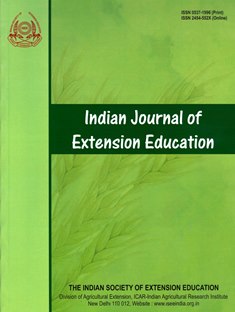A Study on Constraints of Ericulture in Dhemaji District of Assam
DOI:
https://doi.org/10.48165/IJEE.2023.59136Keywords:
Ericulture, Sericulture, Constraints, Women participation, Silkworm rearing, MarketingAbstract
Sericulture might be considered as an important area for uplifting the economy of rural masses of Assam as the nature has endowed with favorable climatic and environmental conditions for various silk producing worms and their food plants. The research study was undertaken in the purposively selected Dhemaji districts of Assam during the year 2022 with the objectives to study profile characteristics of Eri rearers and to explore the problems faced by them. A total of 120 farmers were selected as respondents and data were collected by following simple random sampling technique by the personal interview method using standardized structured interview schedule. Constraints faced by the Eri silkworm rearers were majorly categorized into five broad categories, viz., personal problem, non-availability of resources, problems during rearing of silkworm, marketing problems and problems related to post cocoon sector of sericulture Appropriate statistical tools viz. frequency, percentage, mean was employed to analyze the data. Findings revealed that majority of the respondents termed “lack of capital” (2.86), “unavailability of rearing equipment” (2.66), “could not get seed in time” (2.88), “involvement of middle men” (2.75) and “lack of availability of spinning machine” (2.73) as the most serious problem under each category.
Downloads
References
Anonymous (2020c). https://sericulture.assam.gov.in/frontimpotent data/role-of-women-in-sericultureindustry#:~:text=Presently%2C %20about%2060% 25% 20of% 20total,the%20proud%20of%20 silk%20industry
Anonymous (2020d). https://transdev.assam.gov.in/sites/default/files/ swf_utility_folder/departments/pndd_medhassu_in_oid_2/portlet/ level_2/statistical_handbook_assam_-_2021.pdf
Anonymous (2021a). Note On Sericulture CSB 2021 22 | PDF | Silk (scribd.com)
Anonymous (2021b). https://sericulture.assam.gov.in/how-to/know about-silk-and-its-production-in-assam#:~:text=Assam%20 Contributes%2095%25%20and%2065,traditionally%20 producing%20Muga%20%26%20Eri%20silks.
Bhol, M., Mishra, M., Raj, R. K., & Mishra, J. R. (2020). A study on constraints accruing Lodha women in the micro project developmental programmes. Indian Journal of Extension Education, 56(1), 49-53.
Borah, M. (2019). Liveliood diversification of muga and non muga rearers– A comparative study in Majuli district of Assam. M.Sc. (Agri.). Thesis, Assam Agricultural University, Jorhat.
Bukhari, R., Kour, H., & Abdul, A. (2019). Women and the Indian sericulture industry. International Journal of Current Microbiology and Applied Sciences, 8(5), 857-871.
Dewangan, S. K. (2017). Employment Generation and Socio Economic Change through Sericulture in Raigarh District, Chhattisgarh, India. Annals of Natural Sciences, 3(2): 32-42.
Gangopadhyay, D. (2008). Silk Industry in India-A Review. Indian Science & Technology, NISTDS-CSIR, New Delhi.
Girish, C. E., Kadian, K. S., & Mandi, B. M. K. (2020). Socio economic profile of farmers in sericulture based dairy farming system in Karnataka State, India. International Journal of Current Microbiology and Applied Sciences, 9(4): 2071-2078.
Gogoi, R., & Barman, S. (2020). Degree of farm women participation in sericulture activities–A study in Sivasagar District of Assam. International Journal of Current Microbiology and Applied Science, 9(11), 3195-3202.
Goswami, C., & Bhattacharya, M. (2013) Contribution of sericultureto women’s income in Assam - A case study in Goalpara district of Assam, India. International Journal of Scientific and Research Publications, 3(3), 1-6.
Hatibaruah, D., Dutta, L. C., & Saikia, H. (2022). Adoption Behaviour of sericulture farmers regarding improved technologies of Jorhat District of Assam. Indian Journal of Extension Education, 58(1), 26-30.
Hazare, T. N., Jadav, A. D. (2008). Sericulture brings better income. Indian Silk, 46(9).
Mech, D., Ahmed, S. A. (2012). Participatory profiles of women in Eri culture in Assam State of India. European Journal of Applied Sciences, 4(4), 177-181.
Rabha, P., & Saikia, M. (2021). Women participation in Eri culture with special reference to Kamrup district of Assam. Indian Journal of Extension Education, 57(4), 28-31.
Sarkar, K., Majumdar, M., & Ghosh, A. (2017). Critical analysis on role of women in sericulture industry. International Journal of Social Sciences, 6(3): 211-222.
Downloads
Published
Issue
Section
License

This work is licensed under a Creative Commons Attribution-NonCommercial-NoDerivatives 4.0 International License.

